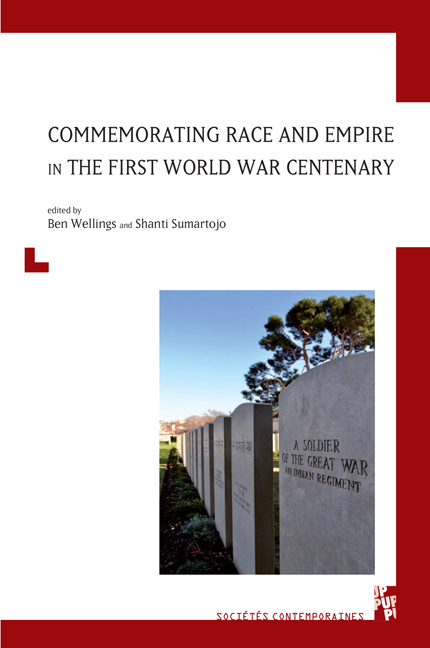Book contents
- Frontmatter
- Contents
- Commemorating Race and Empire in the First World War Centenary
- Rediscovering and Rehabilitating Empire, 2014-2018
- Representing Race and Empire, 1900-1920
- Resénégalisation and the Representation of Black African Troops during World War One
- ‘A Strange, New Race’: Eugenics and the Australian Soldier in the First World War
- The First Circle of Memory: First World War Postcards of British Imperial Troops in Marseilles
- Aesthetic Form and Political Function: Representations of French Algerian and British Indian Troops in First World War Recruiting Posters
- Memorialising Race and Empire in Settler Societies, 1919-2018
- Contibutor Biographies
- Index terms
The First Circle of Memory: First World War Postcards of British Imperial Troops in Marseilles
from Representing Race and Empire, 1900-1920
- Frontmatter
- Contents
- Commemorating Race and Empire in the First World War Centenary
- Rediscovering and Rehabilitating Empire, 2014-2018
- Representing Race and Empire, 1900-1920
- Resénégalisation and the Representation of Black African Troops during World War One
- ‘A Strange, New Race’: Eugenics and the Australian Soldier in the First World War
- The First Circle of Memory: First World War Postcards of British Imperial Troops in Marseilles
- Aesthetic Form and Political Function: Representations of French Algerian and British Indian Troops in First World War Recruiting Posters
- Memorialising Race and Empire in Settler Societies, 1919-2018
- Contibutor Biographies
- Index terms
Summary
“ ‘Marsels!’ ‘We have reached Marsels!’ ‘Hip Hip Hurrah!’ The sepoys were shouting excitedly on deck. Lalu got up from where he sat watching a game of cards and went to see Marseilles”.
The opening lines of Muluk Raj Anand's well informed and celebrated novel Across the Black Waters (1940) offer us a striking snapshot of the way British Imperial troops first set eyes on a country where many were destined to shed their blood. Indeed, the harbor of Marseilles was the first French city most of these soldiers had ever seen. During the First World War, substantial numbers of British troops, be they South Africans, New Zealanders, Australians, Indians or West Indians, passed through Marseilles, France's second largest city after Paris. Marseilles was and had always been cosmopolitan, founded by Greek traders in antiquity, hence it is sometimes known as the ‘Phocean city’. In France, it had come to be known from an early stage as ‘the door to the Orient’. However, as colonialists, soldiers, missionaries or traders left France's shore from Marseilles in the nineteenth century, another influx of people from across the world entered France through what Matthew Graves calls the ‘gateway to the remem–brance trails’. The landing of these foreign troops sparked off great enthusiasm amongst the Marseilles population. There was general consensus among the people that the arrival of the non-European soldiers was a unique event that merited a place in the collective memory of the city, in particular through the production and publication of iconographic documents, such as photographs. Indeed, at the turn of the nineteenth and twentieth century, images had become an increasingly fashionable source of preserving memory. While photographs had many other uses that shall not be discussed here, this article focuses on photographic postcards, souvenirs that people could keep and share with others. Such postcards were amongst the most attractive sources of memory, as they were a quick, simple and pleasant means of reviving and preserving memory in the shape of a souvenir object. Indeed, both the verb ‘to remember’ and the noun ‘souvenir’ share the same word in French, ‘(se) souvenir’ and ‘un souvenir’, highlighting the direct and intimate link between the object as a token of memory, and the act of remembering.
- Type
- Chapter
- Information
- Commemorating Race and Empire in the First World War Centenary , pp. 107 - 130Publisher: Liverpool University PressPrint publication year: 2018

